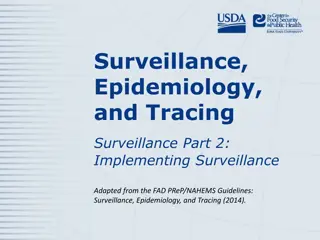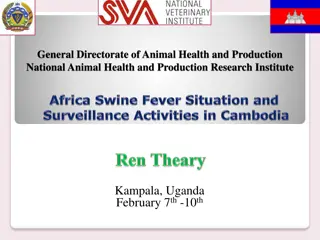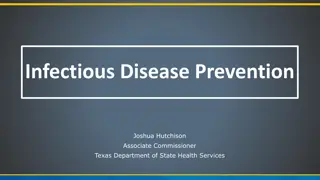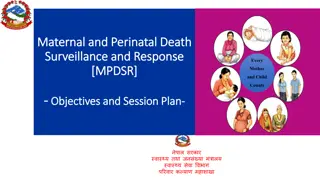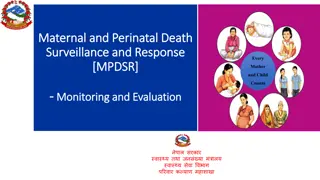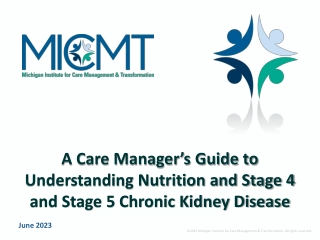Principles of Epidemiology: Understanding Disease Occurrence and Surveillance
Epidemiology is the study of disease patterns, factors influencing disease occurrence, and the core functions of surveillance, field investigation, and analytic studies. It involves understanding disease characteristics, natural history, and evaluating the effectiveness of activities to mitigate disease outbreaks.
Download Presentation
Please find below an Image/Link to download the presentation.
The content on the website is provided AS IS for your information and personal use only. It may not be sold, licensed, or shared on other websites without obtaining consent from the author. Download presentation by click this link. If you encounter any issues during the download, it is possible that the publisher has removed the file from their server.
Presentation Transcript
Surveillance, Epidemiology, and Tracing Epidemiology Part 1: Principles of Epidemiology Adapted from the FAD PReP/NAHEMS Guidelines: Surveillance, Epidemiology, and Tracing (2014).
This Presentation Introduction to epidemiology Overview of disease characteristics Disease occurrence Understanding data and measures of disease FAD PReP/NAHEMS Guidelines: Surveillance, Epi, and Tracing - Epidemiology Part 1 USDA APHIS and CFSPH
What is Epidemiology? Study of disease in populations and factors that determine the occurrence of disease FAD PReP/NAHEMS Guidelines: Surveillance, Epi, and Tracing - Epidemiology Part 1 USDA APHIS and CFSPH
Functions of Epidemiology FAD PReP/NAHEMS Guidelines: Surveillance, Epi, and Tracing - Epidemiology Part 1 USDA APHIS and CFSPH
Core Functions Surveillance Ongoing data collection, analysis, interpretation, and dissemination Used to determine specific actions for FAD mitigation Field investigation Used to collect additional information about cases identified via surveillance Disease source, history of disease, etc. FAD PReP/NAHEMS Guidelines: Surveillance, Epi, and Tracing - Epidemiology Part 1 USDA APHIS and CFSPH
Core Functions (contd) Analytic studies Utilizes information gleaned from surveillance activities and field investigations Disease rates and risk factors Evaluation Effectiveness Efficacy Impact of activities FAD PReP/NAHEMS Guidelines: Surveillance, Epi, and Tracing - Epidemiology Part 1 USDA APHIS and CFSPH
Disease Characteristics FAD PReP/NAHEMS Guidelines: Surveillance, Epi, and Tracing - Epidemiology Part 1 USDA APHIS and CFSPH
Natural History of Disease Course of disease progression Pathogen exposure Subclinical illness Onset of clinical signs Recovery, disability, or death FAD PReP/NAHEMS Guidelines: Surveillance, Epi, and Tracing - Epidemiology Part 1 USDA APHIS and CFSPH
Transmission Modes Many ways to transmit disease Direct transmission Indirect transmission Zoonotic diseases Diseases transmissible between animals and humans May be transmitted directly or indirectly FAD PReP/NAHEMS Guidelines: Surveillance, Epi, and Tracing - Epidemiology Part 1 USDA APHIS and CFSPH
Disease Occurrence FAD PReP/NAHEMS Guidelines: Surveillance, Epi, and Tracing - Epidemiology Part 1 USDA APHIS and CFSPH
Levels of Disease Endemic Disease present in population or geographical area at all times Outbreak Occurrence of more cases of disease than expected Given area/group, specific time period May be used interchangeably with the term epidemic FAD PReP/NAHEMS Guidelines: Surveillance, Epi, and Tracing - Epidemiology Part 1 USDA APHIS and CFSPH
Levels of Disease (contd) Pandemic An outbreak/epidemic that has spread over several countries FAD PReP/NAHEMS Guidelines: Surveillance, Epi, and Tracing - Epidemiology Part 1 USDA APHIS and CFSPH
Causation Environment Husbandry, housing, climate/season, presence of vectors Agent Host range, environmental resistance, tissue affinity, dose, mode of transmission Host Species, breed, age, nutritional and immune status FAD PReP/NAHEMS Guidelines: Surveillance, Epi, and Tracing - Epidemiology Part 1 USDA APHIS and CFSPH
Risk Factors A characteristic that is associated with an increase in the occurrence of a particular disease May include: Age Species Location Contact FAD PReP/NAHEMS Guidelines: Surveillance, Epi, and Tracing - Epidemiology Part 1 USDA APHIS and CFSPH
Understanding Data and Measures of Disease FAD PReP/NAHEMS Guidelines: Surveillance, Epi, and Tracing - Epidemiology Part 1 USDA APHIS and CFSPH
Descriptive Statistics Measures of central tendency Mean, median, and mode Range Difference between largest and smallest value Standard deviation Spread around mean value of data set FAD PReP/NAHEMS Guidelines: Surveillance, Epi, and Tracing - Epidemiology Part 1 USDA APHIS and CFSPH
Confidence Interval Represents range within which the true value lies Calculated based on a percentage 95% commonly used 95% confidence interval True value falls within the given range 95 percent of the time FAD PReP/NAHEMS Guidelines: Surveillance, Epi, and Tracing - Epidemiology Part 1 USDA APHIS and CFSPH
Measures of Disease Prevalence Total number of cases of a disease in a given population at a specific time Incidence Number of new cases of disease in a defined populationover a specific time period FAD PReP/NAHEMS Guidelines: Surveillance, Epi, and Tracing - Epidemiology Part 1 USDA APHIS and CFSPH
Measures of Disease (contd) Mortality rate Number of deaths in a defined population during a specific time period Case fatality rate Percentage of animals diagnosed with a specific disease who die as a result of the disease within a specified period of time FAD PReP/NAHEMS Guidelines: Surveillance, Epi, and Tracing - Epidemiology Part 1 USDA APHIS and CFSPH
Measures of Association Examines the differences in occurrence of disease in different segments of the population Factors that might influence disease occurrence Risk ratio and odds ratio FAD PReP/NAHEMS Guidelines: Surveillance, Epi, and Tracing - Epidemiology Part 1 USDA APHIS and CFSPH
Displaying Data Tables, graphs, and charts Visual means for comparing data Demonstrate patterns, differences, and other relationships FAD PReP/NAHEMS Guidelines: Surveillance, Epi, and Tracing - Epidemiology Part 1 USDA APHIS and CFSPH
Displaying Data (contd) Maps and GIS Geographic location of disease Levels and rates of disease FAD PReP/NAHEMS Guidelines: Surveillance, Epi, and Tracing - Epidemiology Part 1 USDA APHIS and CFSPH
For More Information FAD PReP/NAHEMS Guidelines: Surveillance, Epidemiology, and Tracing, and SOP: Surveillance http://www.aphis.usda.gov/fadprep Surveillance, Epidemiology, and Tracing web-based training module http://naherc.sws.iastate.edu/ FAD PReP/NAHEMS Guidelines: Surveillance, Epi, and Tracing - Epidemiology Part 1 USDA APHIS and CFSPH
Guidelines Content Authors (CFSPH) Kerry Leedom Larson, DVM, MPH, PhD, DACVPM Glenda Dvorak, DVM, MPH, DACVPM Janice Mogan, DVM Courtney Blake, BA Reviewers (USDA APHIS VS) Dr. R. Alex Thompson Dr. Lowell Anderson Dr. Steve Goff Dr. Fred Bourgeois FAD PReP/NAHEMS Guidelines: Surveillance, Epi, and Tracing - Epidemiology Part 1 USDA APHIS and CFSPH
Acknowledgments Development of this presentation was by the Center for Food Security and Public Health at Iowa State University through funding from the USDA APHIS Veterinary Services PPT Authors: Patricia Futoma, Veterinary Student; Kerry Leedom Larson, DVM, MPH, PhD, DACVPM Reviewers: Janice Mogan, DVM; Melissa Lang, BS


